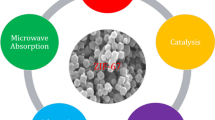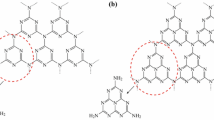Abstract
The asymmetrical zinc phthalocyanine–multiwalled carbon nanotube hybrid material (aZnPc–MWCNT) were successfully prepared by in situ click chemistry of 4-(m-tolyloxygen)-5-nitrophthalonitrile and 4-azide-phthalonitrile modified MWCNT precursors in the Cu(I)/DBU catalyst system. In situ click chemistry reactions and covalent bonds between aZnPc and MWCNT were confirmed by FT-IR, UV–Vis and fluorescence spectra. The aZnPc–MWCNT red-shifted 12–690 nm compared with pristine ZnPc. The microstructure and morphology of aZnPc–MWCNT were investigated by TEM, SEM and AFM. The solubility of aZnPc–MWCNT could be significantly improved. After the ZnPc were uniformly distributed on the surface of MWCNTs, the aggregation of aZnPc–MWCNT was significantly reduced. The thermal degradation temperature of aZnPc–MWCNT was 72.8 °C higher than that of pristine ZnPc. TG results also indicated that the ZnPc content of aZnPc–MWCNT is 14.4%. It is expected that novel organic–inorganic donor–acceptor hybrid material possessing good solubility, optical and thermal stability properties would be obtained, and new materials for the preparation of organic electronic devices should be provided.










Similar content being viewed by others
References
W. Zhao, S. Li, H. Yao, S. Zhang, Y. Zhang, B. Yang, J. Hou, Molecular optimization enables over 13% efficiency in organic solar cells. J. Am. Chem. Soc. 139(21), 7148–7151 (2017)
H. Bin, Z.G. Zhang, L. Gao, S. Chen, L. Zhong, L. Xue, C. Yang, Y. Li, Non-fullerene polymer solar cells based on alkylthio and fluorine substituted 2D-conjugated polymers reach 9.5% efficiency. J. Am. Chem. Soc. 138(13), 4657–4664 (2016)
B.M. Squeo, V.G. Gregoriou, A. Avgeropoulos, S. Baysec, S. Allard, U. Scherf, C.L. Chochos, BODIPY-based polymeric dyes as emerging horizon materials for biological sensing and organic electronic applications. Prog. Polym. Sci. 71, 26–52 (2017)
C. Pan, K. Kou, Y. Zhang, Z. Li, G. Wu, Enhanced through-plane thermal conductivity of PTFE composites with hybrid fillers of hexagonal boron nitride platelets and aluminum nitride particles. Composites B 153, 1–8 (2018)
B. Kan, H. Feng, X. Wan, F. Liu, X. Ke, Y. Wang, Y. Wang, H. Zhang, C. Li, J. Hou, Y. Chen, Small-molecule acceptor based on the heptacyclic benzodi (cyclopentadithiophene) unit for highly efficient nonfullerene organic solar cells. J. Am. Chem. Soc. 139(13), 4929–4934 (2017)
G. Wu, Z. Jia, Y. Cheng, H. Zhang, X. Zhou, H. Wu, Easy synthesis of multi-shelled ZnO hollow spheres and their conversion into hedgehog-like ZnO hollow spheres with superior rate performance for lithium ion batteries. Appl. Surf. Sci. 464, 472–478 (2019)
X. Zhu, Y. Yuan, L. Li, Y. Du, F. Li, Identification of interfacial transition zone in asphalt concrete based on nano-scale metrology techniques. Mater. Des. 129, 91–102 (2017)
Q. Xie, Y. Cheng, S. Chen, G. Wu, Z. Wang, Z. Jia, Dielectric and thermal properties of epoxy resins with TiO2 nanowires. J. Mater. Sci.: Mater. Electron. 28, 17871–17880 (2017)
L. Yang, S. Zhang, C. He, J. Zhang, H. Yao, Y. Yang, Y. Zhang, W. Zhao, J. Hou, New wide band gap donor for efficient fullerene-free all-small-molecule organic solar cells. J. Am. Chem. Soc. 139(5), 1958–1966 (2017)
Z. Wang, J. Liu, Y. Cheng, S. Chen, M. Yang, J. Huang, H. Wang, G. Wu, H. Wu, Alignment of boron nitride nanofibers in epoxy composite films for thermal conductivity and dielectric breakdown strength improvement. Nanomaterials 8(4), 242 (2018)
H. Lv, Y. Guo, G. Wu, G. Ji, Y. Zhao, Z.J. Xu, Interface polarization strategy to solve electromagnetic wave interference. ACS Appl. Mater. Interfaces 9, 5660–5668 (2017)
Z. Jia, D. Lan, K. Lin, M. Qin, K. Kou, G. Wu, H. Wu, Progress in low-frequency microwave absorbing materials. J. Mater. Sci.: Mater. Electron. 29, 17122–17136 (2018)
C.O. Baker, X. Huang, W. Nelson, R.B. Kaner, Polyaniline nanofibers: broadening applications for conducting polymers. Chem. Soc. Rev. 46(5), 1510–1525 (2017)
Z. Yang, S. Chen, Y. Zhao, P. Zhou, Z. Cheng, Hg2+ chromogenic and fluorescence indicators based on rhodamine derivatives bearing thiophene group. Sens. Actuators B 266, 422–428 (2018)
X.P. Kong, X. Shen, J. Jang, X. Gao, Electron pair repulsion responsible for the peculiar edge effects and surface chemistry of black phosphorus. J. Phys. Chem. Lett. 9(5), 947–953 (2018)
C.P. Reis, R.J. Neufeld, F. Veiga, Preparation of drug-loaded polymeric nanoparticles. In Nanomedicine in Cancer (Pan Stanford, Singapore, 2017), pp. 197–240
Z. Yang, K. Fu, J. Yu, P. Zhou, Z. Cheng, Preparation and characterization of temperature-and pH-responsive diblock copolymers and their silica-coated nanoparticles. Polym. Adv. Technol. 29(8), 2273–2280 (2018)
M. Saliba, T. Matsui, J.Y. Seo, K. Domanski, J.P. Correa-Baena, M.K. Nazeeruddin, S.M. Zakeeruddin, W. Tress, A. Abate, A. Hagfeldt, M. Grätzel, Cesium-containing triple cation perovskite solar cells: improved stability, reproducibility and high efficiency. Energy Environ. Sci. 9(6), 1989–1997 (2016)
Z. Yang, S. Chen, K. Fu, X. Liu, F. Li, Y. Du, P. Zhou, Z. Cheng, Highly efficient adsorbent for organic dyes based on a temperature-and pH-responsive multiblock polymer. J. Appl. Polym. Sci. 135(34), 46626 (2018)
X. Ma, B. Zhang, Q. Cong, X. He, M. Gao, G. Li, Organic/inorganic nanocomposites of ZnO/CuO/chitosan with improved properties. Mater. Chem. Phys. 178, 88–97 (2016)
A. Rabti, N. Raouafi, A. Merkoçi, Bio (sensing) devices based on ferrocene–functionalized graphene and carbon nanotubes. Carbon 108, 481–514 (2016)
N. Karousis, I. Suarez-Martinez, C.P. Ewels, N. Tagmatarchis, Structure, properties, functionalization, and applications of carbon nanohorns. Chem. Rev. 116(8), 4850–4883 (2016)
D. Sun, T. Lu, F. Xiao, X. Zhu, G. Sun, Formulation and aging resistance of modified bio-asphalt containing high percentage of waste cooking oil residues. J. Clean. Prod. 161, 1203–1214 (2017)
A. Alam, C. Wan, T. McNally, Surface amination of carbon nanoparticles for modification of epoxy resins: plasma-treatment vs. wet-chemistry approach. Eur. Polym. J. 87, 422–448 (2017)
V. Eskizeybek, A. Avcı, A. Gülce, Preparation and mechanical properties of carbon nanotube grafted glass fabric/epoxy multi-scale composites. Adv. Compos. Mater. 26(2), 169–180 (2017)
Z. Yang, K. Fu, J. Yu, X. Shi, P. Zhou, Z. Cheng, Facile preparation of nanoporous C60/P3HT thin films from PLA-b-C60-b-P3HT triblock copolymers. Appl. Surf. Sci. 458, 70–76 (2018)
U. Alam, M. Fleisch, I. Kretschmer, D. Bahnemann, M. Muneer, One-step hydrothermal synthesis of Bi-TiO2 nanotube/graphene composites: An efficient photocatalyst for spectacular degradation of organic pollutants under visible light irradiation. Appl. Catal. B 218, 758–769 (2017)
J.U. Lee, B. Park, B.S. Kim, D.R. Bae, W. Lee, Electrophoretic deposition of aramid nanofibers on carbon fibers for highly enhanced interfacial adhesion at low content. Composites A 84, 482–489 (2016)
D. Sun, G. Sun, X. Zhu, F. Ye, J. Xu, Intrinsic temperature sensitive self-healing character of asphalt binders based on molecular dynamics simulations. Fuel 211, 609–620 (2018)
M. Li, Z. Wang, Q. Liu, S. Wang, Y. Gu, Y. Li, Z. Zhang, Carbon nanotube film/epoxy composites with high strength and toughness. Polym. Compos. 38(3), 588–596 (2017)
A. Servant, I. Jacobs, C. Bussy, C. Fabbro, T. Da Ros, E. Pach, B. Ballesteros, M. Prato, K. Nicolay, K. Kostarelos, Gadolinium-functionalised multi-walled carbon nanotubes as a T1 contrast agent for MRI cell labelling and tracking. Carbon 97, 126–133 (2016)
B.O. Agboola, K.I. Ozoermena, T. Nyokong et al., Tuning the physic electrochemical properties of novel cobalt octa [(3,5-biscarboxylate)-phenoxy] phthalocyanine complex using phenylamine functionalized SWCNTs. Carbon 48, 763–773 (2010)
Z. Yang, X. Shi, J. Yuan, H. Pu, Y. Liu, Preparation of poly (3-hexylthiophene)/graphene nanocomposite via in situ reduction of modified graphite oxide sheets. Appl. Surf. Sci. 257(1), 138–142 (2010)
Z. Yang, D.A. Wicks, C.E. Hoyle, H. Pu, J. Yuan, D. Wan, Y. Liu, Newly UV-curable polyurethane coatings prepared by multifunctional thiol-and ene-terminated polyurethane aqueous dispersions mixtures: preparation and characterization. Polymer 50(7), 1717–1722 (2009)
N.A. Karim, S.K. Kamarudin, Novel heat-treated cobalt phthalocyanine/carbon-tungsten oxide nanowires (CoPc/C-W18O49) cathode catalyst for direct methanol fuel cell. J. Electroanal. Chem. 803, 19–29 (2017)
S. Leonardo, M. Campàs, Electrochemical enzyme sensor arrays for the detection of the biogenic amines histamine, putrescine and cadaverine using magnetic beads as immobilisation supports. Microchim. Acta 183(6), 1881–1890 (2016)
W. Huang, J.M. Ahlfield, P.A. Kohl, X. Zhang, Heat treated tethered iron phthalocyanine carbon nanotube-based catalysts for oxygen reduction reaction in hybrid fuel cells. Electrochim. Acta 257, 224–232 (2017)
H. Li, F. Cheng, A.M. Duft, A. Adronov, Functionalization of single-walled carbon nanotubes with well-defined polystyrene by “click” coupling. J. Am. Chem. Soc. 127, 14518–14524 (2005)
S. Campidelli, B. Ballesteros, A. Filoramo, D. Díaz Díaz, G. de la Torre, T. Torres, G.M. Aminur Rahman, C. Ehli, D. Kiessling, F. Werner, V. Sgobba, D.M. Guldi, C. Cioffi, M. Prato, J. Bourgoin, Facile decoration of functionalized single-wall carbon nanotubes with phthalocyanines via “click chemistry”. J. Am. Chem. Soc. 130, 11503–11509 (2008)
M. Hu, X. Chen, S. Chen, T. Ou, M. Yao, L. Gu, Z. Huang, J. Tan. A new application of click chemistry in situ: development of fluorescent probe for specific G-quadruplex topology. Sci. Rep. 5, 17202 (2015)
Z. Liu, G. Xu, M. Zhang, K. Xiong, P. Meng, Synthesis of CoFe2O4/RGO nanocomposites by click chemistry and electromagnetic wave absorption properties. J. Mater. Sci.: Mater. Electron. 27, 9278–9285 (2016)
S. Rana, H. Yoo, J. Cho, B. Chun, J. Park, Functionalization of multi-walled carbon nanotubes with poly(ε-caprolactone) using click chemistry. J. Appl. Polym. Sci. 199(1), 31–37 (2010)
Z. Wei, L. Du, L. Wang, Cross-linking carbon nanotubes by glycidyl azide polymer via click chemistry. J. Nanosci. Nanotechnol. 12(1), 787–792 (2012)
Acknowledgements
This study was funded by National Natural Science Foundation of China (Nos. 51622805 and U1633116) and the opening fund for the subject of Transportation Engineering in Tongji University (2016J012306). The authors are grateful to these financial supports.
Author information
Authors and Affiliations
Corresponding author
Ethics declarations
Conflict of interest
The authors declare that they have no conflict of interest.
Rights and permissions
About this article
Cite this article
Yang, Z., Yu, J., Fu, K. et al. Facile preparation of asymmetric phthalocyanine/multi-walled carbon nanotube hybrid material by in situ click chemistry. J Mater Sci: Mater Electron 29, 21078–21087 (2018). https://doi.org/10.1007/s10854-018-0255-y
Received:
Accepted:
Published:
Issue Date:
DOI: https://doi.org/10.1007/s10854-018-0255-y




